 W
WThe biological treatment of wastewater in the sewage treatment plant is often accomplished using conventional activated sludge systems. These systems generally require large surface areas for treatment and biomass separation units due to the generally poor settling properties of the sludge. Aerobic granules are a type of sludge that can self-immobilize flocs and microorganisms into spherical and strong compact structures. The advantages of aerobic granular sludge are excellent settleability, high biomass retention, simultaneous nutrient removal and tolerance to toxicity. Recent studies show that aerobic granular sludge treatment could be a potentially good method to treat high strength wastewaters with nutrients, toxic substances.
 W
WAn air purge system is used to flush electrical control equipment with clean air before it is turned on. This ensures that the functionality of the equipment is not affected or damaged by the contaminants from the surrounding environment.
 W
WAn ASTM Smoke Pump, or 'spot pump', is an instrument for evaluating the dark particle concentration of a smoke. It is very widely used (2014) by heating engineers to assess emissions, most commonly from fuel-burning appliances such as a wood stoves or oil boilers. It consists of a cylinder of precise size down which a close-fitting piston is pulled, sucking a sample of the smoke through a small nozzle against a filter paper so that a 'spot' is formed on the paper, the darkness of which can be compared with a standard chart to indicate the concentration of smoke.
 W
WBaffle spray scrubbers are a technology for air pollution control. They are very similar to spray towers in design and operation. However, in addition to using the energy provided by the spray nozzles, baffles are added to allow the gas stream to atomize some liquid as it passes over them.
 W
WA baghouse, also known as a baghouse filter, bag filter, or fabric filter is an air pollution control device and dust collector that removes particulates or gas released from commercial processes out of the air. Power plants, steel mills, pharmaceutical producers, food manufacturers, chemical producers and other industrial companies often use baghouses to control emission of air pollutants. Baghouses came into widespread use in the late 1970s after the invention of high-temperature fabrics capable of withstanding temperatures over 350 °F (177 °C).
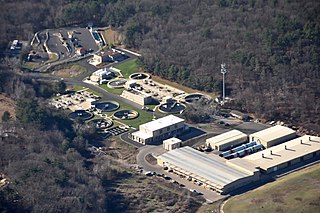 W
WSewage treatment is the process of removing contaminants from domestic and municipal wastewater, containing mainly household sewage plus some industrial wastewater. Physical, chemical, and biological processes are used to remove contaminants and produce treated wastewater that is safe enough for release into the environment. A by-product of sewage treatment is a semi-solid waste or slurry, called sewage sludge. The sludge has to undergo further treatment before being suitable for disposal or application to land.
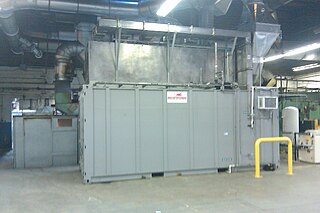 W
WA biological oxidizer is a device that uses micro-organisms to treat wastewater and the volatile organic compounds produced by commercial and industrial operations. Biological oxidation devices convert biodegradable organic compounds into carbon dioxide and water. This is a natural occurring process which differs from traditional chemical and thermal oxidizing agents and methods. Some of the more commonly used micro-organisms are heterotrophic bacteria, which play an important role in biological degradation processes. Generally, these micro-organisms are rod shaped and facultative. Biological oxidizers provide a stable environment which allows bacteria to naturally oxidize and stabilize a large number of organics in a more efficient manner. Some of the emissions that may be treated biologically include:heterocyclic compounds ; polyaromatic hydrocarbons (PAHs); pharmaceutical substances; polychlorinated biphenyls; hydrocarbons (oil); benzene, toluene, ethylbenzene, and xylene (BETEX); methyl ethyl ketone (MEK); some metals.
 W
WA crankcase ventilation system removes unwanted gases from the crankcase of an internal combustion engine. The system usually consists of a tube, a one-way valve and a vacuum source.
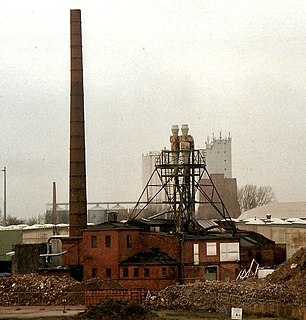 W
WCyclonic separation is a method of removing particulates from an air, gas or liquid stream, without the use of filters, through vortex separation. When removing particulate matter from liquid, a hydrocyclone is used; while from gas, a gas cyclone is used. Rotational effects and gravity are used to separate mixtures of solids and fluids. The method can also be used to separate fine droplets of liquid from a gaseous stream.
 W
WCyclonic spray scrubbers are an air pollution control technology. They use the features of both the dry cyclone and the spray chamber to remove pollutants from gas streams.
 W
WDiesel exhaust fluid is a liquid used to reduce the amount of air pollution created by a diesel engine. Specifically, DEF is an aqueous urea solution made with 32.5% urea and 67.5% deionized water. DEF is consumed in selective catalytic reduction (SCR) that lowers the concentration of nitrogen oxides in the diesel exhaust emissions from a diesel engine.
 W
WThe ECO Funnel, also known as the "Safety Ecological Funnel", is a funnel intended to be affixed to a receptacle for liquid chemical waste. It is designed to reduce environmental contamination, in compliance with OSHA and EPA mandated safety protocols.
 W
WAn ejector or jet venturi scrubber is an industrial pollution control device, usually installed on the exhaust flue gas stacks of large furnaces, but may also be used on any number of other air exhaust systems. This type of technology is a part of the group of air pollution controls collectively referred to as wet scrubbers. Although operating in similar ways to a venturi scrubber the ejector venturi is not driven by the flow of process gas and instead the energy is derived from the high-pressure spray of liquid from a nozzle, allowing the scrubber to also act as a vacuum ejector and draw process gas through the device without external assistance.
 W
WAn electrostatic precipitator (ESP) is a filterless device that removes fine particles, like dust and smoke, from a flowing gas using the force of an induced electrostatic charge minimally impeding the flow of gases through the unit.
 W
WEnvironmental remediation deals with the removal of pollution or contaminants from environmental media such as soil, groundwater, sediment, or surface water. Remedial action is generally subject to an array of regulatory requirements, and may also be based on assessments of human health and ecological risks where no legislative standards exist, or where standards are advisory.
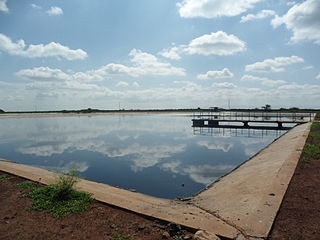 W
WFacultative lagoons are a type of waste stabilization pond used for biological treatment of industrial and domestic wastewater. Sewage or organic waste from food or fiber processing may be catabolized in a system of constructed ponds where adequate space is available to provide an average waste retention time exceeding a month. A series of ponds prevents mixing of untreated waste with treated wastewater and allows better control of waste residence time for uniform treatment efficiency.
 W
WFlue-gas desulfurization (FGD) is a set of technologies used to remove sulfur dioxide from exhaust flue gases of fossil-fuel power plants, and from the emissions of other sulfur oxide emitting processes such as waste incineration.
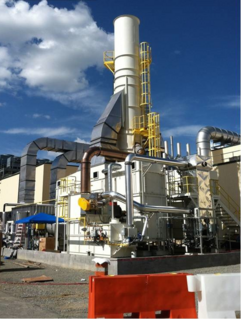 W
WA fluidized bed concentrator (FBC) is an industrial process for the treatment of exhaust air. The system uses a bed of activated carbon beads to adsorb volatile organic compounds (VOCs) from the exhaust gas. Evolving from the previous fixed-bed and carbon rotor concentrators, the FBC system forces the VOC-laden air through several perforated steel trays, increasing the velocity of the air and allowing the sub-millimeter carbon beads to fluidize, or behave as if suspended in a liquid. This increases the surface area of the carbon-gas interaction, making it more effective at capturing VOCs.
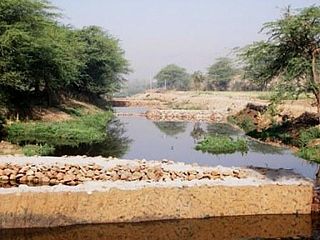 W
WGreen bridges are an ecotechnological in-situ bio remediation system. Their different physical and biological filters work in combination to remove suspended and dissolved impurities of water. Green bridge filters help in reducing the suspended solids by filtration process, reducing Chemical Oxygen Demand (COD)/Biochemical Oxygen Demand (BOD) by aerobic degradation. Green Bridges also help in the restoration of ecological food chain.
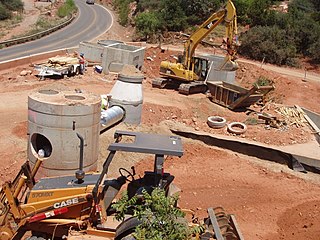 W
WHydrodynamic separators (HDS) are stormwater management devices that use cyclonic separation to control water pollution. They are designed as flow-through structures with a settling or separation unit to remove sediment and other pollutants. HDS are considered structural best management practices (BMPs), and are used to treat and pre-treat stormwater runoff.
 W
WSynthetic dyes are found in a wide range of products such as clothes, leather accessories, and furniture. These dyes are commonly used every day. However, a side effect of their widespread use is that up to 12% of these dyes are wasted during the dying process and about 20% of this wastage enters the environment.
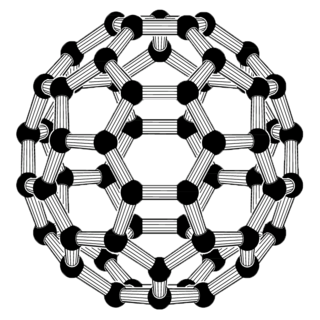 W
WNanoscale iron particles are sub-micrometer particles of iron metal. They are highly reactive because of their large surface area. In the presence of oxygen and water, they rapidly oxidize to form free iron ions. They are widely used in medical and laboratory applications and have also been studied for remediation of industrial sites contaminated with chlorinated organic compounds.
 W
WLead abatement is an activity to reduce levels of lead, particularly in the home environment, generally to permanently eliminate lead-based paint hazards, in order to reduce or eliminate incidents of lead poisoning.
 W
WLiving Machine is a form of ecological sewage treatment. Similar to Solar Aquatics Systems, the latest generation of the technology is based on fixed-film ecology.
 W
WA LO NOx burner is a type of burner that is typically used in utility boilers to produce steam and electricity.
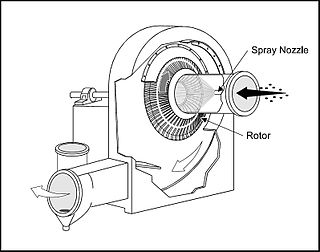 W
WMechanically aided scrubbers are a form of pollution control technology. This type of technology is a part of the group of air pollution controls collectively referred to as wet scrubbers.
 W
WSecondary treatment is a treatment process for wastewater to achieve a certain degree of effluent quality by using a sewage treatment plant with physical phase separation to remove settleable solids and a biological process to remove dissolved and suspended organic compounds. After this kind of treatment, the wastewater may be called as secondary-treated wastewater.
Septic drain fields, also called leach fields or leach drains, are subsurface wastewater disposal facilities used to remove contaminants and impurities from the liquid that emerges after anaerobic digestion in a septic tank. Organic materials in the liquid are catabolized by a microbial ecosystem.
 W
WSewage treatment is the process of removing contaminants from domestic and municipal wastewater, containing mainly household sewage plus some industrial wastewater. Physical, chemical, and biological processes are used to remove contaminants and produce treated wastewater that is safe enough for release into the environment. A by-product of sewage treatment is a semi-solid waste or slurry, called sewage sludge. The sludge has to undergo further treatment before being suitable for disposal or application to land.
 W
WShewanella oneidensis is a bacterium notable for its ability to reduce metal ions and live in environments with or without oxygen. This proteobacterium was first isolated from Lake Oneida, NY in 1988, hence its name.
 W
WBoyan Slat is a Dutch inventor and entrepreneur. A former aerospace engineering student, he is the CEO of The Ocean Cleanup.
 W
WA spray tower is gas-liquid contactor used to achieve mass and heat transfer between a continuous gas phase and a dispersed liquid phase. It consists of an empty cylindrical vessel made of steel or plastic, and nozzles that spray liquid into the vessel. The inlet gas stream usually enters at the bottom of the tower and moves upward, while the liquid is sprayed downward from one or more levels. This flow of inlet gas and liquid in opposite directions is called countercurrent flow.
 W
WSewage treatment is the process of removing contaminants from domestic and municipal wastewater, containing mainly household sewage plus some industrial wastewater. Physical, chemical, and biological processes are used to remove contaminants and produce treated wastewater that is safe enough for release into the environment. A by-product of sewage treatment is a semi-solid waste or slurry, called sewage sludge. The sludge has to undergo further treatment before being suitable for disposal or application to land.
 W
WA trickling filter is a type of wastewater treatment system. It consists of a fixed bed of rocks, coke, gravel, slag, polyurethane foam, sphagnum peat moss, ceramic, or plastic media over which sewage or other wastewater flows downward and causes a layer of microbial slime (biofilm) to grow, covering the bed of media. Aerobic conditions are maintained by splashing, diffusion, and either by forced-air flowing through the bed or natural convection of air if the filter medium is porous.
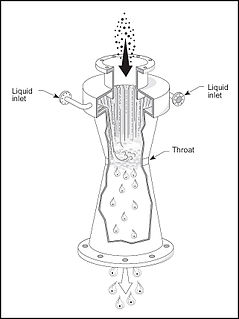 W
WA venturi scrubber is designed to effectively use the energy from a high-velocity inlet gas stream to atomize the liquid being used to scrub the gas stream. This type of technology is a part of the group of air pollution controls collectively referred to as wet scrubbers.
 W
WA wheel washing system is a device for cleaning the tires of trucks when they are leaving a site, to control and eliminate the pollution of public roads. The installation can be made in or above the ground for either temporary or permanent applications. There are two types of wheel washing systems: roller and drive-through systems.